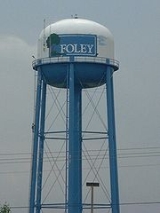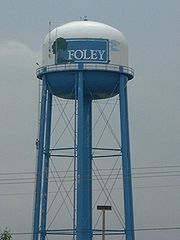
Foley, Alabama
Encyclopedia

Baldwin County, Alabama
-2010:Whereas according to the 2010 U.S. Census Bureau:*85.7% White*9.4% Black*0.7% Native American*0.7% Asian*0.0% Native Hawaiian or Pacific Islander*1.5% Two or more races*4.4% Hispanic or Latino -2000:...
, Alabama
Alabama
Alabama is a state located in the southeastern region of the United States. It is bordered by Tennessee to the north, Georgia to the east, Florida and the Gulf of Mexico to the south, and Mississippi to the west. Alabama ranks 30th in total land area and ranks second in the size of its inland...
, United States
United States
The United States of America is a federal constitutional republic comprising fifty states and a federal district...
.
The 2000 census lists the population of the city as 7,590.
Foley is a principal city of the Daphne
Daphne, Alabama
Daphne is a city in Baldwin County, Alabama, United States, on the eastern shoreline of Mobile Bay. The city is located along I-10, 11 miles east of Mobile and 150 miles southwest of the state capital of Montgomery. The United States Census 2000 lists the population of the city as 16,581 making...
–Fairhope
Fairhope, Alabama
Fairhope is a city in Baldwin County, Alabama, on a sloping plateau, along the cliffs and shoreline of Mobile Bay. The 2010 census lists the population of the city as 16,176....
–Foley Micropolitan Statistical Area, which includes all of Baldwin County.
History
Foley was founded by John B. Foley of Chicago. As Foley was traveling to President McKinley's funeral in 1901, he met a railroad agent who told him of the area in South Baldwin County. Foley came down the following year, liked what he saw and bought up between 40000 acres (161.9 km²) and 50000 acres (202.3 km²) of land. He returned to Chicago and formed the Magnolia Land Company. As he began to sell off acreage, he realized the need for a better way for the people to come to Foley. Foley used some of his own money to lay the rails so the train could come from Bay Minette. The first railroad station was built in 1905. The original station burned in 1908 and was replaced the following year by the station that is now the City's museum. John Foley donated parcels of land for a school and churches. The first train to service Foley was a wood burner called the "Pine Knot Special." It would leave Foley in the morning and make a return trip in the afternoon. As people cleared the land, they would place liter knots in a wood box for the engineer to use as was needed. Foley was incorporated in 1915 with G. I. Weatherly serving as its first mayor.Geography
Foley is located at 30°24'20.138" North, 87°40'53.432" West (30.405594, -87.681509).According to the U.S. Census Bureau, the city has a total area of 14.3 sq mi (37 km²), of which, 14.3 sq mi (37 km²) of it is land and 0.07% is water.
Demographics
As of the censusCensus
A census is the procedure of systematically acquiring and recording information about the members of a given population. It is a regularly occurring and official count of a particular population. The term is used mostly in connection with national population and housing censuses; other common...
of 2000, there were 7,590 people, 3,126 households, and 2,106 families residing in the city. The population density
Population density
Population density is a measurement of population per unit area or unit volume. It is frequently applied to living organisms, and particularly to humans...
was 531.5 people per square mile (205.2/km²). There were 3,468 housing units at an average density of 242.8 per square mile (93.8/km²). The racial makeup of the city was 74.49% White
Race (United States Census)
Race and ethnicity in the United States Census, as defined by the Federal Office of Management and Budget and the United States Census Bureau, are self-identification data items in which residents choose the race or races with which they most closely identify, and indicate whether or not they are...
, 21.86% Black
Race (United States Census)
Race and ethnicity in the United States Census, as defined by the Federal Office of Management and Budget and the United States Census Bureau, are self-identification data items in which residents choose the race or races with which they most closely identify, and indicate whether or not they are...
or African American
Race (United States Census)
Race and ethnicity in the United States Census, as defined by the Federal Office of Management and Budget and the United States Census Bureau, are self-identification data items in which residents choose the race or races with which they most closely identify, and indicate whether or not they are...
, 0.59% Native American
Race (United States Census)
Race and ethnicity in the United States Census, as defined by the Federal Office of Management and Budget and the United States Census Bureau, are self-identification data items in which residents choose the race or races with which they most closely identify, and indicate whether or not they are...
, 0.55% Asian
Race (United States Census)
Race and ethnicity in the United States Census, as defined by the Federal Office of Management and Budget and the United States Census Bureau, are self-identification data items in which residents choose the race or races with which they most closely identify, and indicate whether or not they are...
, 0.04% Pacific Islander
Race (United States Census)
Race and ethnicity in the United States Census, as defined by the Federal Office of Management and Budget and the United States Census Bureau, are self-identification data items in which residents choose the race or races with which they most closely identify, and indicate whether or not they are...
, 1.32% from other races
Race (United States Census)
Race and ethnicity in the United States Census, as defined by the Federal Office of Management and Budget and the United States Census Bureau, are self-identification data items in which residents choose the race or races with which they most closely identify, and indicate whether or not they are...
, and 1.15% from two or more races. 4.64% of the population were Hispanic
Race (United States Census)
Race and ethnicity in the United States Census, as defined by the Federal Office of Management and Budget and the United States Census Bureau, are self-identification data items in which residents choose the race or races with which they most closely identify, and indicate whether or not they are...
or Latino
Race (United States Census)
Race and ethnicity in the United States Census, as defined by the Federal Office of Management and Budget and the United States Census Bureau, are self-identification data items in which residents choose the race or races with which they most closely identify, and indicate whether or not they are...
of any race.
There were 3,126 households out of which 27.3% had children under the age of 18 living with them, 48.4% were married couples
Marriage
Marriage is a social union or legal contract between people that creates kinship. It is an institution in which interpersonal relationships, usually intimate and sexual, are acknowledged in a variety of ways, depending on the culture or subculture in which it is found...
living together, 15.7% had a female householder with no husband present, and 32.6% were non-families. 28.2% of all households were made up of individuals and 14.0% had someone living alone who was 65 years of age or older. The average household size was 2.35 and the average family size was 2.85.
In the city the population was spread out with 23.1% under the age of 18, 8.3% from 18 to 24, 25.9% from 25 to 44, 20.9% from 45 to 64, and 21.7% who were 65 years of age or older. The median age was 40 years. For every 100 females there were 84.6 males. For every 100 females age 18 and over, there were 79.7 males.
The median income for a household in the city was $31,596, and the median income for a family was $38,427. Males had a median income of $28,523 versus $20,660 for females. The per capita income
Per capita income
Per capita income or income per person is a measure of mean income within an economic aggregate, such as a country or city. It is calculated by taking a measure of all sources of income in the aggregate and dividing it by the total population...
for the city was $19,364. About 7.1% of families and 0.5% of the population were below the poverty line, including 13.4% of those under age 18 and 12.0% of those age 65 or over.
Education
Foley is a part of the Baldwin County Public Schools system.An elementary school, an intermediate school, a middle school, and a high school serve Foley.
The Foley Public Library has in excess of 50,000 volumes, internet computers, children's reading programs and public meeting rooms for civic organizations. Its web site is www.foleylibrary.org.

